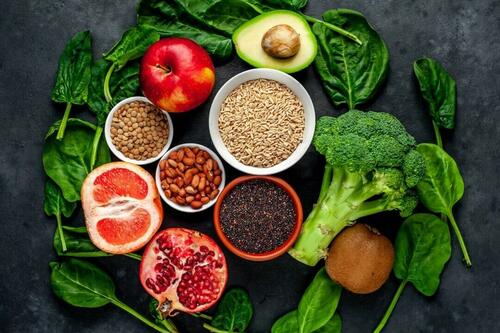“These Results Are Alarming”: Billions Of People Have Inadequate Micronutrients, Study Estimates
Authored by Huey Freeman via The Epoch Times (emphasis ours),
More than half the world’s population is deficient in micronutrients such as vitamins and minerals, according to a new study.
According to the results, published in Lancet Global Health journal, 99.3 percent of the global population is missing at least one important nutrient.
Selection of “healthy” foods: fruits, seeds, cereals, and vegetables.
The study collected data from 31 countries to estimate micronutrient consumption in 185 countries.
“Our study is a big step forward,” Chris Free, research professor at the Harvard T.H. Chan School of Public Health, UC Santa Barbara, and co-lead author, said. “Not only because it is the first to estimate inadequate micronutrient intakes for 34 age-sex groups in nearly every country, but also because it makes these methods and results easily accessible to researchers and practitioners.”
Deficiencies in micronutrients harm health and can lead to various preventable health conditions, the researchers say.
“Iron deficiency is the most common cause of anaemia, leading to impaired cognition and adverse pregnancy outcomes. Vitamin A deficiency is the leading cause of preventable blindness globally, affecting mostly children and pregnant women,” the authors wrote in their study.
“These results are alarming,” Ty Beal, lead author of the study, said in a press release. “These gaps compromise health outcomes and limit human potential on a global scale.”
The researchers said the new study is the first to provide global estimates of inadequate consumption of 15 micronutrients critical to human health.
“These results can be used by public health practitioners to target populations in need of intervention,” the researchers added.
Seven Common Deficiencies
The researchers identified seven common micronutrients that people are deficient in, namely iodine, vitamin E, calcium, iron, riboflavin (vitamin B2), folate, and vitamin C.
Vitamin E, iodine, and vitamin C are also common deficiencies in the United States, the authors wrote.
More than half the children in the world younger than 5 years old are deficient in vitamin A, iron, or zinc.
Each micronutrient deficiency has unique consequences, with multiple deficiencies potentially lowering quality of life and lifespan. The study revealed several global deficiency rates:
Iodine (68 percent): Vital for cognitive development in infants. Iodine plays an essential role for pregnant and breastfeeding women. Common sources of iodine are iodized salt, seaweed, and seafood.
Vitamin E (67 percent): Deficiency can cause muscle weakness and impaired coordination. Nuts, seeds, and vegetable oils are common sources of vitamin E.
Calcium (66 percent): Deficiencies can cause weak and brittle bones. Dairy and fish are common sources of calcium.
Iron (65 percent): Deficiencies can cause anemia, affecting cognition and pregnancy outcomes. Red meat and eggs are common sources of iron.
Riboflavin (55 percent): Deficiencies can cause non-specific symptoms like eye sensitivity and neurological symptoms like seizures and migraines. Eggs, meat, and dairy are main sources of riboflavin.
Folate (54 percent): Folate is needed early in pregnancy to reduce the risk of stillbirths and severe birth defects of the brain and spinal cord. Nuts and leafy greens are main sources of folate.
Vitamin C (53 percent): Deficiencies can cause gum bleeding and poor wound healing. Peppers, tomatoes, and citrus fruits are common sources of vitamin C.
Other less common deficiencies include inadequate vitamin A and zinc. Vitamin A deficiencies can cause blindness and zinc helps prevent infectious disease.
The researchers found that females consistently showed higher deficiency rates for iodine, iron, and the mineral selenium. Males, however, were more deficient in magnesium, vitamin B6, zinc, vitamin C, vitamin A, thiamin (vitamin B1), and niacin (vitamin B3).
Tyler Durden
Wed, 09/04/2024 – 22:25

